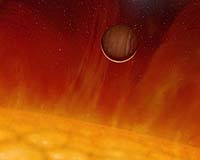 Five billion years from now the Sun will expand into as a bloated red giant star, swallowing the inner planets. Credit: STScI
Five billion years from now the Sun will expand into as a bloated red giant star, swallowing the inner planets. Credit: STScI |
This preoccupation with doomsday has inspired science fiction tales depicting the end of Earth, including a recent TV miniseries Impact, and the upcoming motion picture 2012 that is described as "an epic adventure about a global cataclysm that brings an end to the world and tells of the heroic struggle of the survivors."
Today's astronomers don't need the Mayan calendar, or Nostradamus, or Hollywood's imagination to explore the solar system's far future fate. Observations of planets around other stars, combined with stellar evolution theory and supercomputer simulations give us a reasonable prediction of what's in store for the solar system.
As their parent stars inevitability age and burn out, every inhabited planet across our galaxy faces the ultimate apocalypse due to fundamental changes in a star's energy output and its physical diameter.
Yet the emerging view of what happens to planets at the end of a star's life is more complex than scientists once thought. What's more, the ever-shifting fortunes of survivability in the universe suggest one planet's apocalypse may be another world's genesis.
Roughly 5 billion years from now, the Sun will go through a late-life crisis as nuclear fusion reactions change in the core. The Sun will begin to swell as a red giant. Like a runaway hot air balloon, the Sun's outer layers will reach escape velocity and peel off into space.
As the Sun begins losing mass, the planets' orbits will widen because the Sun's gravitational pull will grow weaker. But Mercury and Venus will not get far enough away to avoid being engulfed by the ballooning red giant. Earth will migrate out to Mars' current orbit, but still may not survive. Mars the Red Planet will move proportionally farther out.
The Sun's evolution into a red giant certainly will render the inner solar system uninhabitable. Yet all hope may not be lost. The "habitable zone" - the radius from a star where water can remain liquid under room temperatures - will expand along with the Sun. This will warm once-frozen planets and their moons, bringing a brief springtime after a 10-billion-year winter.
As the Sun balloons to a red giant, the habitable zone will sweep through a range of 200 million to 900 million miles radius. Under the warm glare of the giant Sun, the frozen moons orbiting the outer planets, such as Europa, Ganymede, and Enceladus will have their icy crust melt quickly into liquid water.
Ancient craters will dissolve into the warming seas. After being in hibernation for all of its star's main sequence lifetime, the moons' newborn oceans, laden with a carbon-rich broth, could spring to life.
Life on Earth may have begun as soon as a few tens of millions of years after Earth cooled down from its fiery birth. If life elsewhere could form within a billion years of when conditions become ripe, then inhabitable planets could exist around the aging Sun and other red giant stars. Life could then have a chance to develop in a newly extended habitable zone.
Once frozen and carbon-rich moons like Saturn's Titan would thaw out and become incubators for the first stages of life. This could even stretch out to Neptune's moon Triton - which is now one of the coldest places in the solar system. At the Sun's peak output as a red giant, even distant Pluto and other icy dwarf planets would get slushy, but for only about 10 million years or less.
As the Sun finally burns out and gravitationally collapses to a white dwarf, the outer planets will quickly chill and reach colder conditions than before.
The watery moons will quickly ice over and life will face mass extinction. The only source of energy left for life to survive will be gravitational tidal forces that would warm subsurface oceans. So, even when the Sun is reduced to a cold cinder, life could still hang on in the interiors of the outer moons.
In the final days, asteroids and comets may be dislodged by the gravitational pull of Jupiter, and sent falling in toward the white dwarf. Dwarf-grazing asteroids would be tidally torn apart to make a dusty ring around the dwarf. In 2004 The Spitzer Space Telescope found a Saturn-like dust ring around the white dwarf G29-38, which may have been created by tidal disruption of a comet passing too close to the white dwarf.
Even in these post-apocalyptic days there will still be a habitable zone in the solar system, but it will be very close to the white dwarf. As the dwarf slowly cools the zone will move in closer, like a noose around a neck.
If any large asteroids survive, like the dwarf planet Ceres, they could also be the last holdout for life if they can get close enough to the dwarf's feeble glow without being gravitationally ripped apart. Ceres is believed to have an icy mantle, and so microbial life might eke out an existence in the twilight years of the solar system.

No comments:
Post a Comment